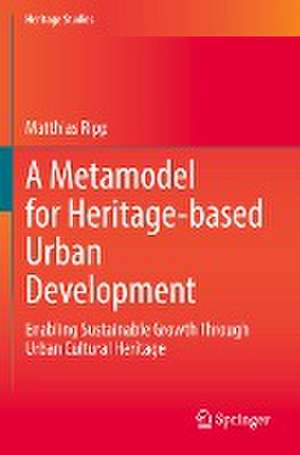A Metamodel for Heritage-based Urban Development: Enabling Sustainable Growth Through Urban Cultural Heritage: Heritage Studies
Autor Matthias Rippen Limba Engleză Paperback – 17 sep 2023
The Metamodel was developed using grounded theory and design research methodology and is based on three successful case-models from European contexts. The book includes three application scenarios that elaborate how the metamodel can be used to design, evaluate, and improve processes where cultural heritage is a starting point forsustainable urban development.
| Toate formatele și edițiile | Preț | Express |
|---|---|---|
| Paperback (1) | 553.56 lei 38-44 zile | |
| Springer International Publishing – 17 sep 2023 | 553.56 lei 38-44 zile | |
| Hardback (1) | 568.44 lei 38-44 zile | |
| Springer International Publishing – 16 sep 2022 | 568.44 lei 38-44 zile |
Preț: 553.56 lei
Preț vechi: 691.95 lei
-20% Nou
Puncte Express: 830
Preț estimativ în valută:
105.92€ • 110.60$ • 87.47£
105.92€ • 110.60$ • 87.47£
Carte tipărită la comandă
Livrare economică 11-17 aprilie
Preluare comenzi: 021 569.72.76
Specificații
ISBN-13: 9783031082405
ISBN-10: 3031082400
Pagini: 209
Ilustrații: XXXII, 209 p. 38 illus. in color.
Dimensiuni: 155 x 235 mm
Ediția:1st ed. 2022
Editura: Springer International Publishing
Colecția Springer
Seria Heritage Studies
Locul publicării:Cham, Switzerland
ISBN-10: 3031082400
Pagini: 209
Ilustrații: XXXII, 209 p. 38 illus. in color.
Dimensiuni: 155 x 235 mm
Ediția:1st ed. 2022
Editura: Springer International Publishing
Colecția Springer
Seria Heritage Studies
Locul publicării:Cham, Switzerland
Cuprins
Part 1. Theories, Methods and Research Design.- Chapter 1. Problem at stake: No universal method to use urban heritage as a resource for development. Chapter 2. Definition of Terms.- Chapter 3. Introduction: Hypothesis and Key Research Questions.- Chapter 4. Theoretical Background.- Chapter 5. Disciplinary approach.- Chapter 6. Proposed Solution and Mixed-Method Research Design.- Chapter 7. Epistemology and Integration of Metamodeling Theory.- Part 2. Application of Research Methods.- Chapter 8. Research Methods.- Part 3. Description, Application and Demonstrations of the Metamodel.- Chapter 9. Description of the Metamodel.- Chapter 10. Application of the Metamodel.- Chapter 11. Demonstration.- Chapter 12. Additional Resources to design specific Heritage Based Development Processes with the Metamodel.
Recenzii
“Metamodel for Heritage- Based Urban Development, is a valuable contribution to urban heritage studies as it offers a new methodology for understanding the complexity of the topic. … The systemic approach presented in this book responds to this need as it brings together theories, personal experiences … . The approach presented here is equally useful for students of heritage studies focusing on process. The research methodology is inspiring for researchers in the heritage field.” (Yonca Erkan, Built Heritage, Vol. 7 (1), 2023)
Notă biografică
Dr. Matthias Ripp, a senior heritage manager with a background of historical geography, is coordinating the “Old Town of Regensburg with Stadtamhof” site. He is active in numerous networks such as Heritage Europe and ICOMOS. He coordinated the EU HerO (Heritage as Opportunity) project and chairs the UNESCO world heritage working group on historic city centres of the German Association of Cities. Since November 2011 he has also been regional coordinator for the North West European and North-American region of the Organisation of World Heritage Heritage Cities (OWHC), is teaching at different Universities and works as a trainer, facilitator and consultant.
Textul de pe ultima copertă
This book proposes a Metamodel for heritage-based urban development, based on urban morphology, governance theory, and the metamodeling concept of John P. Van Gigch. Building on international policies such as the 2011 Recommendation for Historic Urban Landscapes and the results of the 2016 Urban Habitat III Conference, cultural heritage is now regarded as a potential resource for sustainable urban development. While more and more evidence of the potential benefits of cultural heritage for sustainable development has been published, this book is the first to develop and design a Metamodel that can be universally applied in a wide variety of settings.
The Metamodel was developed using grounded theory and design research methodology and is based on three successful case-models from European contexts. The book includes three application scenarios that elaborate how the metamodel can be used to design, evaluate, and improve processes where cultural heritage is a starting point forsustainable urban development.
The Metamodel was developed using grounded theory and design research methodology and is based on three successful case-models from European contexts. The book includes three application scenarios that elaborate how the metamodel can be used to design, evaluate, and improve processes where cultural heritage is a starting point forsustainable urban development.
Caracteristici
First universally applicable metamodel to design Heritage-based Urban Development Processes Groundbreaking approach how to use Urban Heritage to Improve the Quality of Life Offers first general applicable metamodel to use Urban Heritage for Sustainable Development













